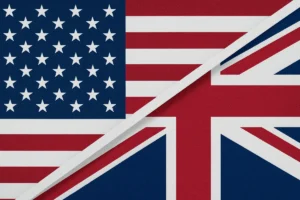With the announcement of massively higher reciprocal tariffs on April 2, President Trump has demonstrated again that he wants a pivotal shift in the global economic and political order. In essence, he seeks a departure from the multilateral rules-based system, that has been in place since the middle of the 20th century, to a more unilateral America-first approach.
There are three defining characteristics of the tariff shock:
1.) Central banks regard it as a stagflationary political shock. Their best response is to wait and assess the economic consequences as they come rather than cutting policy rates prematurely.
2.) Trust in the rules-based international trade order and a predictable economic environment has been severely damaged. This will reduce investment spending and increase household savings rates, both of which increase recession risks significantly.
3.) The US administration sees tariffs only as a first step to correct a supposedly “rigged” system. It is likely to address non-tariff trade barriers, foreign regulations that impact services exports of US companies next. Being a huge net debtor to the rest of the world, we wouldn’t be surprised if the US government would at some point attempt to apply measures of financial repression to foreign investors to lower the cost of servicing their public debt. Currently, it seems that the US treasury market is the most powerful factor that could constrain excessive policy ideas.
The damage is done
In the past few days, it has been difficult to keep track of the exact tariff rates the US wants to impose on its trading partners – and partners may not even be the appropriate word anymore. Still, we tried and calculated that the different tariffs the US will apply increase its average rate from 2.5% at the end of last year to around 30%, though heavily skewed against China. Some of these additional tariffs on China could be negotiated away. Independent of the scenarios, there are three main features of the tariff shock that we consider important for financial markets:
Central banks cannot respond to a politically induced shock like COVID or GFC
Firstly, it is important to note that central banks cannot respond to a politically induced shock in the same way as they did during COVID or the Global Financial Crisis. In the latter two, central banks had to assume that the crisis would deepen without their action. In a political shock, they have to consider that further political action could deepen or end it. This means that they should wait before cutting policy rates until they see an impact on either the labour market, inflation or the financial system as a whole. Otherwise, they risk being trapped in a monetary policy stance that could quickly prove to be inappropriate. As a result, political shocks are more likely to lead to a sell-off in both bond and equity markets that are more often experienced in Emerging Markets.
Central banks treat tariffs the US is imposing as a negative supply shock that makes both a recession and higher inflation more likely. They are right to wait to see which of the two effects prevails before changing policy rates. They would consider that tariffs are intended to reorganise the global pattern of production and trade, but away from the current more efficient allocation. If that happens slowly over time companies can adjust and shift factors of production from one country to another. However, if it happens overnight some business models might collapse, and a large part of their capital stock has to be written off completely. This would be different from a normal recession where a period of cyclical underutilisation is usually followed by cyclical recovery of their activity and their profits.
High uncertainty will prevail
Secondly, independent of the final outcome of future tariff negotiations, trust has been lost in the US as a reliable trading partner, the global rules-based trading system, the checks and balances of the US political system where in the past decisions were not made by just one individual. Higher uncertainty again acts like an additional tax on businesses, consumers and investors alike. This should discourage companies from investing, households from consuming and investors from buying US assets. Overall, this will lead to a demand shock. We consider a contraction of US GDP in Q2 as likely. The layoffs induced by DOGE will add to the uncertainties and income losses for households.
The current US administration is serious in reorganising the global trade order
Thirdly and most importantly, the announced tariffs seem to be only the first step in a series of attempts to increase production in the US, to tax foreign countries, and to isolate China economically. Peter Navarro, President’s Trump counsellor for trade and manufacturing, clearly stated in an Op-ed in the Financial Times this week that tariffs were only the beginning of a change to a global system “rigged” against the US. Non-tariff trade barriers might be addressed next as well as other impediments to the services trade that restrict US companies from operating abroad the way they can domestically. Finally, the world should be prepared that the US will try to extract tolls from foreigners for the use of the US centred global payment system and for holding US dollar reserves. Restricting US dollar swap lines to countries that are complying with US demands or access to its security umbrella could be ways to do so. We consider it likely that the US will try to combine preferential tariff treatment, access to its market and financial infrastructure to countries that follow the US in isolating China. Countries would need to take sides, which would be particularly difficult for European and East Asian countries that have equally important relationships with both the US and China.
In a new world order, the cost of capital increases as the allocation becomes less efficient
These three features will lead to a less globalised world in which the allocation of resources will become less efficient than it is now. Global supply chains will be replicated within newly emerging trading blocs. This increases the cost of production, lowers profits and increases inflation. Ultimately, lower trust in each other, fewer business ties, and an international order that is based on might instead of rules and common institutions is also more prone to military conflicts among countries. Fortunately, above developments are not a done deal yet – another reason why we should think in scenarios. Many countries will try to reduce the leverage the US has over them. China showed already that it can resist US pressure and will try to use the growing influence it mainly has in the “Global South”. Europe is ramping up its defence spending and Asian central banks are diversifying their FX-reserves away from the US dollar towards gold.
US bond market the most powerful constraint for unsound economic policies?
We would like to think that the US administration becomes more constrained by US courts and the US congress, which could try to re-establish the system of checks and balances that limited the fallout from controversial policy ideas in the past. However, for the time being it seems that the sell-off in the treasury market was more conducive for Trump’s latest change of mind. This might continue as foreign investors sell their treasury holdings in order to reduce the risk of financial repression, for example through a tax on their interest income. This trend could be amplified if Trump’s tariffs or any new trade deals are successful in reducing the US trade deficit. In that case, foreigners would earn fewer US dollars and would naturally have lower demand for US Treasuries. They might also reconsider the overall US exposure they have in their asset allocation. With the risk that the US government tries to reduce the value of the US dollar, the high valuation of US equities and the overexposure many international investors have to US, some investors may feel less inclined to fund US budget deficits than they have been so far. As a result, increasing Treasury yields might become a constraining factor for the US administration as the well-functioning of the Treasury market is not only vital for the global financial system but also for the US economy itself. Be prepared for a rough ride ahead.
By Karsten Junius, chief economist at J. Safra Sarasin Sustainable Asset Management
















